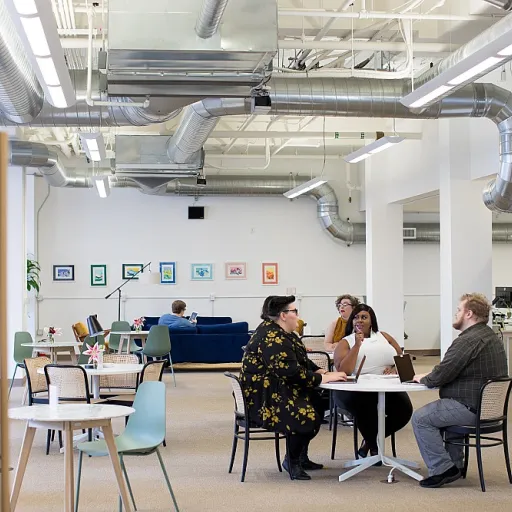
Understanding digital transformation scale agile solutions in HR
How digital transformation is redefining HR
Digital transformation is no longer just a buzzword in the business world. In human resources, it means more than adopting new tools. It’s about changing the way HR teams operate, make decisions, and support business goals. This shift is driven by the need for real time data, scalable agile solutions, and continuous improvement. Companies are moving away from traditional processes and embracing digital solutions that enable faster, more informed decision-making and better collaboration across teams.
The rise of agile methodologies in HR
Agile practices, once reserved for software development, are now being adopted by HR departments to manage change and drive transformation. Agile frameworks help HR teams respond quickly to business needs, adapt to change, and deliver value through iterative processes. This approach supports continuous development and encourages a culture of collaboration and feedback. By scaling agile across the HR function, organizations can better align their people strategies with long term business objectives.
Key components of transformation at scale
- Data-driven decision making: Leveraging analytics and real time insights to guide HR initiatives and measure success.
- Agile leadership: Fostering a mindset of adaptability, transparency, and continuous learning within HR teams.
- Integrated digital tools: Using scalable solutions to streamline processes, enhance project management, and improve the employee experience.
- Collaboration and communication: Breaking down silos and encouraging cross-functional teamwork to achieve transformation goals.
For a deeper look at how technology is shaping HR operations, explore this resource on enhancing HR operations with a comprehensive technology stack. Understanding these foundations sets the stage for the evolving role of the chief human resources officer and the challenges they face in leading digital transformation initiatives.
The evolving role of the chief human resources officer
Shifting from Traditional HR to Strategic Leadership
The chief human resources officer (CHRO) role has evolved far beyond traditional personnel management. Today, CHROs are at the forefront of business transformation, driving digital initiatives and implementing agile solutions to align people strategies with organizational goals. This shift requires a deep understanding of how digital tools, data, and scalable agile frameworks can support business development and continuous improvement.
Championing Digital and Agile Change
Modern CHROs are expected to lead the charge in enterprise digital transformation. They must foster a culture of agility, encouraging teams to adopt agile methodologies and practices that enable rapid response to change. This means moving away from rigid processes and embracing scalable agile approaches that support real time collaboration, project management, and continuous feedback loops.
Integrating Data and Technology into HR Processes
Data-driven decision making is now central to the CHRO’s responsibilities. Leveraging digital solutions, CHROs can analyze workforce data to identify trends, measure the impact of HR initiatives, and align talent management with long term business objectives. The integration of advanced tools and scalable agile solutions allows for more efficient management of HR processes, from recruitment to performance management and beyond. For a deeper dive into how data migration supports these initiatives, explore essential best practices for SAP data migration.
Driving Collaboration and Continuous Improvement
As organizations scale agile practices across departments, CHROs play a critical role in breaking down silos and promoting cross-functional collaboration. They champion continuous improvement by encouraging feedback, supporting agile leadership development, and ensuring that HR teams are equipped to manage change effectively. This agile approach not only enhances HR’s impact but also positions the CHRO as a key driver of business transformation at scale.
Key challenges faced by CHROs during digital transformation
Complexity of Integrating Digital and Agile Practices
Chief human resources officers (CHROs) face significant challenges as they guide their organizations through digital transformation and the adoption of scaled agile solutions. The integration of digital tools and agile methodologies into existing HR processes is rarely straightforward. Many organizations operate with legacy systems and traditional approaches, making the shift to agile frameworks and scalable digital solutions a complex process. CHROs must oversee the alignment of new technologies with business goals, ensuring that transformation initiatives support both short-term needs and long-term development.
Managing Change and Building Buy-In
One of the most demanding aspects of transformation is change management. CHROs are responsible for fostering a culture that embraces continuous improvement and agile leadership. This often means overcoming resistance from teams accustomed to established processes. Effective communication, transparent leadership, and ongoing collaboration are essential for building trust and encouraging adoption of new agile practices. The ability to scale agile solutions across large, diverse teams requires a thoughtful approach to change, balancing the pace of transformation with the need for stability.
Data-Driven Decision Making and Real-Time Adaptation
As digital transformation accelerates, CHROs must leverage data and analytics to inform decision making. The shift to real-time data collection and analysis introduces new challenges in data management, privacy, and security. CHROs need to ensure that HR teams have the skills and tools required to interpret data effectively, supporting agile project management and continuous improvement. The pressure to deliver measurable results in real time can be intense, especially when scaling agile initiatives across the enterprise.
Balancing Standardization and Flexibility
Implementing transformation at scale often requires balancing standardized processes with the flexibility needed for agile development. CHROs must create frameworks that allow for both consistency and adaptability, ensuring that agile solutions can be tailored to the unique needs of different teams and business units. This balancing act is critical for maintaining alignment with overall business objectives while supporting innovation and experimentation.
Talent Development and Agile Team Building
Developing agile teams capable of thriving in a digital environment is another key challenge. CHROs must identify and nurture talent with the right mix of technical, collaborative, and leadership skills. This includes investing in continuous learning and development, promoting agile mindsets, and supporting cross-functional collaboration. Building a pipeline of future-ready leaders is essential for sustaining transformation and achieving long-term business goals.
For a deeper look at how executive search and leadership development are shaping the CHRO role in the context of digital and agile transformation, explore this resource on executive search and leadership development for CHROs.
Essential skills for leading digital transformation in HR
Critical Competencies for Leading HR Transformation
Driving transformation in HR, especially at scale, requires a unique blend of skills. The chief human resources officer (CHRO) must not only understand digital tools and agile methodologies, but also possess the leadership and strategic vision to guide teams through continuous change. The following competencies are essential for CHROs navigating digital transformation and agile solutions in the modern business environment.
- Agile Leadership: The ability to foster an agile mindset across teams is crucial. This means encouraging experimentation, learning from failure, and supporting scalable agile practices that adapt to evolving business needs.
- Change Management Expertise: Leading transformation at scale demands strong change management skills. CHROs must guide teams through new processes, tools, and structures, ensuring alignment with long-term business goals.
- Data-Driven Decision Making: Leveraging real-time data and analytics is fundamental. CHROs should use data to inform talent development, measure the impact of digital initiatives, and drive continuous improvement in HR processes.
- Collaboration and Communication: Effective collaboration across departments is key to successful transformation. CHROs must communicate the vision, facilitate cross-functional teamwork, and ensure everyone understands the value of agile solutions.
- Project and Process Management: Mastery of project management and process optimization enables CHROs to implement scalable agile frameworks and oversee complex digital initiatives efficiently.
- Strategic Business Acumen: Understanding the broader business context allows CHROs to align HR transformation with enterprise digital goals, ensuring that agile solutions support overall organizational development.
Adapting to Continuous Change and Innovation
Transformation is not a one-time event. CHROs must champion continuous improvement, embracing agile practices that allow HR teams to respond quickly to new challenges. This involves staying updated on the latest tools and approaches, fostering a culture of innovation, and ensuring that processes remain flexible as the business scales.
Ultimately, the ability to lead through uncertainty, inspire teams, and drive enterprise digital initiatives sets successful CHROs apart in today’s rapidly evolving landscape.
Building an agile HR team for the future
Fostering Agility through Team Structure and Mindset
Building an agile HR team is not just about adopting new tools or processes. It requires a shift in mindset and structure, aligning with the broader transformation scale happening across the business. Teams need to embrace agile methodologies and frameworks, allowing them to respond quickly to change and deliver value in real time. This involves breaking down silos, encouraging cross-functional collaboration, and promoting continuous improvement in every aspect of HR management.
Key Elements of an Agile HR Team
- Cross-functional Collaboration: Agile HR teams bring together diverse skills and perspectives, enabling them to tackle complex challenges and drive transformation initiatives more effectively.
- Continuous Learning and Development: Ongoing training in digital tools, agile practices, and project management ensures teams stay ahead of industry trends and can scale agile solutions as needed.
- Data-driven Decision Making: Leveraging data and analytics helps teams measure progress, refine processes, and align HR goals with business objectives.
- Empowered Leadership: Agile leadership empowers team members to take ownership of their work, fostering a culture of accountability and innovation.
- Iterative Process Improvement: Teams regularly review and adapt their processes, using feedback and real-time insights to drive continuous improvement and scalable agile outcomes.
Implementing Agile Practices at Scale
For large scale organizations, scaling agile requires a thoughtful approach. This includes selecting the right agile frameworks, such as Scrum or Kanban, and adapting them to fit the unique needs of HR. Enterprise digital transformation often demands a balance between standardized processes and the flexibility to innovate. By adopting scalable agile solutions, HR teams can support long term business goals while remaining adaptable to change.
Tools and Technologies for Agile HR
Digital transformation in HR is powered by a range of tools that support agile practices. From cloud-based collaboration platforms to advanced data analytics and process automation, these solutions enable teams to work more efficiently and transparently. The right technology stack enhances communication, streamlines project management, and provides the insights needed for effective change management and agile development.
Measuring success in digital HR transformation
Defining Metrics That Matter
Measuring the success of digital transformation and scaled agile solutions in HR requires a clear understanding of what matters most to the business. It’s not just about tracking adoption rates of new tools or the number of agile teams formed. Instead, CHROs need to align metrics with strategic business goals, focusing on both short-term wins and long-term development.
- Employee Experience: Use surveys and feedback tools to gauge satisfaction and engagement, especially as new digital processes and agile practices are introduced.
- Process Efficiency: Track improvements in HR processes, such as reduced time-to-hire, faster onboarding, or streamlined performance management, enabled by digital solutions.
- Business Impact: Link HR initiatives to business outcomes, like productivity gains, retention rates, or cost savings, to demonstrate the value of transformation at scale.
- Agile Maturity: Assess how well agile methodologies and frameworks are embedded within teams, using maturity models or regular retrospectives for continuous improvement.
- Data Utilization: Monitor how effectively HR teams use real-time data and analytics for decision-making and forecasting, reflecting a shift toward enterprise digital capabilities.
Tools and Approaches for Real-Time Insights
Modern HR leaders are leveraging a mix of digital tools and agile frameworks to gather and interpret data. Dashboards, people analytics platforms, and project management solutions provide real-time visibility into progress and challenges. These tools support agile leadership by enabling quick adjustments and fostering collaboration across teams.
Regular check-ins, sprint reviews, and feedback loops are essential agile practices that help track the effectiveness of transformation initiatives. By integrating continuous improvement cycles, CHROs can ensure that change is scalable and sustainable, adapting to evolving business needs.
Embedding Continuous Improvement
Success in digital HR transformation is not a one-time achievement. It’s a continuous process that relies on agile methodologies and a culture of learning. CHROs should encourage experimentation, celebrate small wins, and be transparent about setbacks. This approach builds trust and resilience within HR teams, supporting large scale change and long-term business growth.
| Key Area | Example Metrics | Agile/Digital Approach |
|---|---|---|
| Employee Engagement | eNPS, survey response rates | Continuous feedback, real-time pulse checks |
| Process Efficiency | Time-to-hire, onboarding duration | Process automation, agile project management |
| Business Outcomes | Retention, productivity, cost savings | Data-driven decision making, scalable agile initiatives |
| Agile Maturity | Agile maturity scores, number of retrospectives | Scaled agile frameworks, continuous improvement cycles |
By focusing on these areas and embracing a data-driven, agile approach, CHROs can effectively measure and drive the success of digital transformation in HR, ensuring their teams remain adaptive and aligned with the evolving needs of the business.












